
Norwell is a town in Plymouth County, Massachusetts, United States. The population was 10,506 at the 2010 Census. The town's southeastern border runs along the North River.
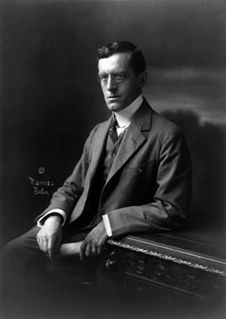
Ralph Adams Cram was a prolific and influential American architect of collegiate and ecclesiastical buildings, often in the Gothic Revival style. Cram & Ferguson and Cram, Goodhue & Ferguson are partnerships in which he worked. Together with the architect Richard Upjohn and artist John LaFarge, he is honored on December 16 as a feast day in the Episcopal Church of the United States. Cram was a fellow of the American Institute of Architects.

Scituate is a seacoast town in Plymouth County, Massachusetts, United States, on the South Shore, midway between Boston and Plymouth. The population was 18,133 at the 2010 census.

The North End is a neighborhood of Boston, Massachusetts, United States. It has the distinction of being the city's oldest residential community, where people have continuously inhabited since it was settled in the 1630s. Though small, only 0.36 square miles (0.93 km2), the neighborhood has nearly one hundred establishments and a variety of tourist attractions. It is known for its Italian American population and Italian restaurants. The district is a pending Boston Landmark.

Timothy Cutler was an American Episcopal clergyman and rector of Yale College.

The Episcopal Diocese of Massachusetts is one of the nine original dioceses of the Episcopal Church in the United States of America.
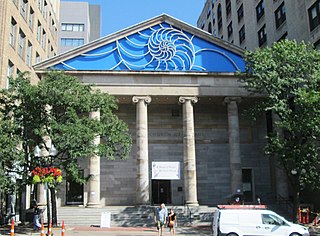
The Cathedral Church of St. Paul, Boston is the historic cathedral church of the Episcopal Diocese of Massachusetts. Located at 138 Tremont Street near Downtown Crossing, directly across from Boston Common and Park Street Station, the cathedral is adjacent to the diocesan offices. The acting dean of the cathedral was the Rev. Nancy Gossling, following the retirement of the Rev. Jep Streit in February 2017. On April 22, 2018, Amy E McCreath was named the ninth dean and first female dean of the Cathedral Church of St Paul, and was installed as dean on September 29, 2018. The church, designed by Alexander Parris and Solomon Willard and built in 1819, was the first Greek Revival church in New England, and was designated a National Historic Landmark in 1970 for its architectural significance.
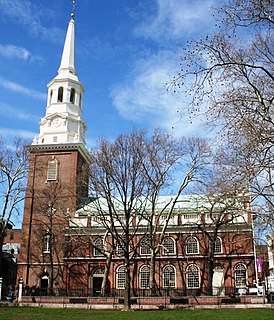
Christ Church is an Episcopal church in the Old City neighborhood of Philadelphia. Founded in 1695 as a parish of the Church of England, it played an integral role in the founding of the Protestant Episcopal Church in the United States. In 1785, its rector, William White, became the first Presiding Bishop of the Episcopal Church.

Saint Paul's Church is a historic Episcopal church in downtown Augusta, Georgia, adjacent to Riverwalk Augusta. A member of the Episcopal Diocese of Georgia, Saint Paul's conducts its worship services using the 1979 Book of Common Prayer. The church, located on the corner of 6th and Reynolds Streets, is the oldest church congregation in Augusta. It was established in 1750 by the Church of England at the site of Fort Augusta. There have been five churches on the site. The current church building, which combines features of Federal architecture with those of the Georgian and Greek Revival styles, was designed by Henry Ten Eyck Wendell and dedicated in 1920. It can seat up to 600 people.

Trinity Church, on Queen Anne Square in Newport, Rhode Island, is a historic parish church in the Episcopal Diocese of Rhode Island. Founded in 1698, it is the oldest Episcopal parish in the state. The current Georgian building was designed by architect Richard Munday and constructed in 1725–26. It is a National Historic Landmark.

Christ Church is a historic Episcopal church at 750 Main Street in Waltham, Massachusetts. The church is a parish of the Episcopal Diocese of Massachusetts, and was named to the National Register of Historic Places in 1989.

Christ Church is a historic church at 12 Quincy Avenue in Quincy, Massachusetts. It is a parish of the Episcopal Diocese of Massachusetts. The parish first congregated for lay-led services in 1689, and officially formed in 1704. It is believed to be the oldest continuously active Episcopal parish in Massachusetts. The building is a Tudor Revival structure constructed in 1874; it was listed on the National Register of Historic Places in 1989. The Rev. Clifford Brown is the current rector.

The Episcopal presence in Canandaigua, New York began, formally, in February, 1799 with the formation of St. Matthew's Episcopal Mission. In 1814, St. John's Episcopal Church was organized and first met in the Ontario County, New York Court House in Canandaigua. St. John's erected a wooden church building in 1816. Bishop John Henry Hobart consecrated it that year. Steady congregational growth necessitated more space. This led to the razing of the first church and the constructing of the current larger stone Gothic building done in the parish church style popular in the 19th century. Emlen T. Littel of New York, who was also the architect of Zion Episcopal Church designed the building. This church was constructed in 1872 at a cost of $47,000 and consecrated in 1886. It contains several windows from the earlier wooden church, elaborate new stained glass windows imported from Europe, and one—The Parables Window—was designed by Daniel Cottier(1837–1891), who was considered an important influence on Louis Comfort Tiffany. In 1908, new hardwood floors, choir stalls, and an organ were installed. The parish house and a chapel were added at the same time. In 1964-65, an addition to parish house included classrooms, a new chapel, and a dining/ meeting room added to celebrate the church's 150th anniversary. Recent additions include a columbarium with a capacity of 136 niches and a memorial garden, outside the church. A capital campaign begun in 2017 allowed the parish to upgrade and improve five areas identified by parishioners as essential priorities.
Andrew Thomas McCormick was an Episcopal clergyman and Chaplain of the United States Senate. Historians sometimes render his name as Alexander Thomas McCormick, likely confusing him with his brother Alexander Hugh McCormick, but his tombstone reads "Andrew Thomas McCormick".
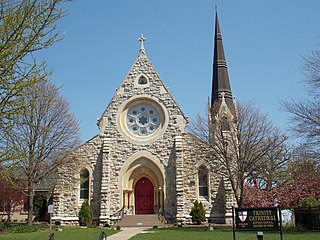
Trinity Episcopal Cathedral, formerly known as Grace Cathedral, is the historic cathedral in the Diocese of Iowa. The cathedral is located on the bluff overlooking Downtown Davenport, Iowa, United States. Completed in 1873, Trinity is one of the oldest cathedrals in the Episcopal Church in the United States. It was individually listed on the National Register of Historic Places in 1974. In 1983 the cathedral was included as a contributing property in the College Square Historic District, which is also listed on the National Register.

John Williams Beal was an architect in Boston, Massachusetts.
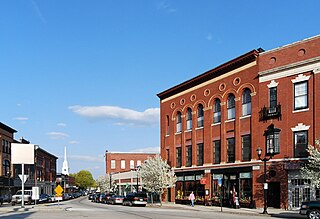
Hudson is a town in Middlesex County, Massachusetts, United States, with a total population of 19,063 as of the 2010 census. Before its incorporation as a town in 1866, Hudson was a neighborhood and unincorporated village of Marlborough, Massachusetts, and was known as Feltonville. From around 1850 until the last shoe factory burned down in 1968, Hudson was a mill town specializing in the production of shoes and related products. At one point the town had 17 shoe factories, many of them powered by the Assabet River, which runs through town. The many factories in Hudson attracted immigrants from Canada and Europe. Today most residents are of either Portuguese or Irish descent, with a smaller percentage being of French, Italian, English, or Scotch-Irish descent. While some manufacturing remains in Hudson, the town is now primarily residential. Hudson is served by the Hudson Public Schools district.

St. John's Episcopal Church is a parish church in the Episcopal Diocese of Iowa. It is located in Keokuk, Iowa, United States. It was listed, together with the parish hall, on the National Register of Historic Places in 1989.


















